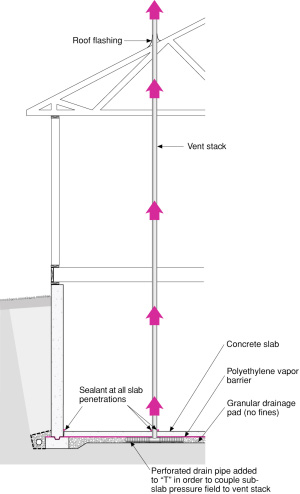Keeping soil gas (radon, water vapor, herbicides, termiticides, methane, etc.) out of foundations cannot be done by building hole-free foundations because hole-free foundations cannot be built. Soil gas moves through holes due to a pressure difference. Since we cannot eliminate the holes, the only thing we can do is control the pressure.
The granular drainage pad located under concrete slabs can be integrated into a sub-slab ventilation system to control soil gas migration by creating a zone of negative pressure under the slab. A vent pipe connects the sub-slab gravel layer to the exterior through the roof. This “passive” radon mitigation system is illustrated in the figure Soil Gas Ventilation System—Basement Construction.
An exhaust fan can be added later, if necessary, to make this an “active” mitigation system.
More information about radon and radon resistance construction can be found on the Environmental Protection Agency’s website at: www.epa.gov/iaq/radon/
See also the following EPA documents:
- “Building Radon Out: A Step-by-Step Guide on How to Build Radon-Resistant Homes”
- “Radon Resistant Construction Architectural Drawings”
- “Model Standards and Techniques for Control of Radon in New Residential Buildings”
Soil Gas Control Detail
Figure 1
Soil Gas Ventilation System—Basement Construction
Granular drainage pad depressurized by active fan located in attic or by passive stack action of warm vent stack located inside heated space.
Avoid offsets or elbows in vent stack to maximize air flow.

